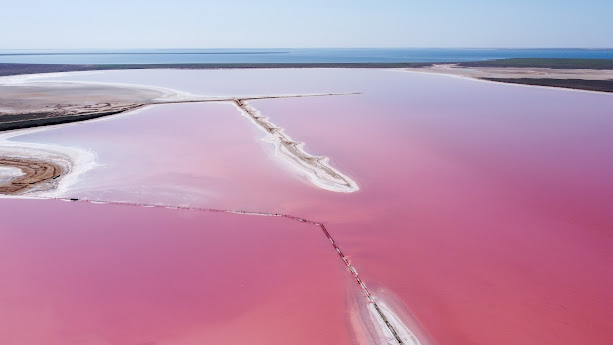Pink lake
ENGLISH:
The pink lake is red or pink in color. It is often caused by salt-tolerant Algae , which produce carotenoids such as Dunaliella salina , usually in combination with specific bacteria, which vary from lake to lake.
Pink lakes are also formed by a combination of factors, including the climate, hydraulics, and especially saltunity of the continent beneath them. The orange-pink color of salt lakes around the world is often said to be caused by the green algae dunaliella salina.
unaliella salina is a highly holopilic (salt-tolerant) algae that can grow at approximately 3%salinity. Single-cell green algae play a key role in primary production in hypersaline environments around the world. At high salinity, temperature and light, this algae accumulates red carotenoid pigment, beta carotene. Carrots with 0.3% beta carotene give the same color.
Beta-carotene protects the algae from excessive light damage, giving the green chlorophyll coating and algae an orange or red color. Because the color of pink lakes is found in many lakes, it has long been thought to be the result of algae.
Some bacteria and archaea form a carotenoid pigment within their cells. This may or may not be the only reason for the bright red color of the lakes. In hundreds of Australian pink lakes, researchers believed that a red bacterium called Salinebacter ruber may have produced their color.
Most pink salt lakes change their color, which is often associated with rainfall. A lake in westgate Park in melbourne, Australia was pink in march 2017, but then dark green from september 2019 to january 2022 .
TAMIL:
இளஞ்சிவப்பு ஏறி என்பது சிவப்பு அல்லது இளஞ்சிவப்பு நிறத்தைக் கொண்டது. இது பெரும்பாலும் உப்பு-சகிப்புத்தன்மை கொண்ட பாசிகள் இருப்பதால் ஏற்படுகிறது, இது டுனாலியெல்லா சலினா போன்ற கரோட்டினாய்டுகளை உற்பத்தி செய்கிறது, பொதுவாக குறிப்பிட்ட பாக்டீரியாவுடன் இணைந்து, இது ஏரிக்கு ஏரி மாறுபடுகிறது.
இளஞ்சிவப்பு ஏரிகள் அவற்றின் கீழ் உள்ள கண்டத்தின் காலநிலை,நீரியல் மற்றும் குறிப்பாக உப்புத்தன்மையின் அளவு உள்ளிட்ட காரணிகளின் கலவையிலிருந்தும் உருவாகின்றன. உலகெங்கிலும் உள்ள உப்பு ஏரிகளின் ஆரஞ்சு இளஞ்சிவப்பு நிறம் பெரும்பாலும் பச்சை ஆல்கா டுனாலியெல்லா சலினாவால் உருவாகிறது என கூறப்படுகிறது.
டுனாலியெல்லா சலினா மிகவும் ஹாலோபிலிக் (உப்பு-சகிப்புத்தன்மை கொண்ட) ஆல்கா ஆகும், இது தோராயமாக 3% உப்புத்தன்மையில் வளரக்கூடியது. உலகெங்கிலும் உள்ள ஹைப்பர்சலைன் சூழல்களில் முதன்மை உற்பத்தியில் ஒற்றை செல் பச்சை ஆல்கா முக்கிய பங்கு வகிக்கிறது. அதிக உப்புத்தன்மை, வெப்பநிலை மற்றும் ஒளியில், இந்த ஆல்கா சிவப்பு கரோட்டினாய்டு நிறமி, பீட்டா கரோட்டின் ஆகியவற்றைக் குவிக்கிறது. 0.3% பீட்டா கரோட்டின் கொண்ட கேரட்டுக்கு அவற்றின் நிறத்தை தருவதும் இதே நிறமிதான்.
பீட்டா-கரோட்டின் அதிக வெளிச்சத்தில் இருந்து பாசியை சேதப்படுத்தாமல் பாதுகாக்கிறது, பச்சை குளோரோஃபில் பூச்சு மற்றும் ஆல்காவிற்கு ஆரஞ்சு அல்லது சிவப்பு நிறத்தை அளிக்கிறது. இளஞ்சிவப்பு ஏரிகளின் நிறம் பல ஏரிகளில் காணப்படுவதால், இது ஆல்காவின் விளைவு என்று நீண்ட காலமாக கருதப்பட்டது.
சில பாக்டீரியாக்கள் மற்றும் ஆர்க்கியாக்கள் அவற்றின் செல்களுக்குள் ஒரு கரோட்டினாய்டு நிறமியை உருவாக்குகின்றன. இது ஏரிகளின் இளஞ் சிவப்பு நிறத்திற்கு பங்களிக்கலாம்அல்லது ஒரே காரணமாக இருக்கலாம். நூற்றுக்கணக்கான ஆஸ்திரேலிய இளஞ்சிவப்பு ஏரிகளில், சாலினிபேக்டர் ரூபர் என்ற சிவப்பு பாக்டீரியம் அவற்றின் நிறத்தை உற்பத்தி செய்து இருக்கலாம் என ஆராய்ச்சியாளர்களால் நம்பப்பட்டது.
பெரும்பாலான இளஞ்சிவப்பு உப்பு ஏரிகள் அவற்றின் நிறத்தை மாற்றுகின்றன, இது பெரும்பாலும் மழைப்பொழிவுடன் இணைக்கப்பட்டுள்ளது. ஆஸ்திரேலியாவின் மெல்போர்னில் உள்ள வெஸ்ட்கேட் பூங்காவில் உள்ள ஒரு ஏரி மார்ச் 2017 ல் இளஞ்சிவப்பு நிறத்தில் இருந்தது, ஆனால் அதன் பின்னர் செப்டம்பர் 2019 முதல் ஜனவரி 2022 வரைைைைை அடர் பச்சை நிறத்தை எடுத்தது.
ஹல்லியர் போன்ற உப்பு நீர் ஏரிகள் கடலைைை விட 10 மடங்கு அதிக உப்பு தன்மை கொண்டுள்ளன. இளஞ்சிவப்பு ஏரிகளில் நீந்துவது உடலுக்கு ஆரோக்கியமானதாகும் ஆனால் அந்த ஏரி நீரை குடிப்பது அதிக உப்புத்தன்மை மற்றும் நுண்ணுயிரிகள் காரணமாக உடல் நலத்திற்கு தீங்கானது ஆகும்.

.jpeg)
.jpeg)

.jpeg)
.jpeg)




0 Comments